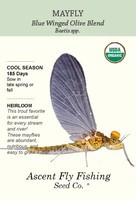
Learn to Anticipate the Next Hot Hatch
Being born and raised in the Mid-West, my life was intimately connected to land. From working on farms and ranches during my early years, to selling sweet corn on the side of the road to pay for college, the seasons were marked by their own unique rhythms of planting and harvest. From the time the seeds were planted, we could count the days to when we would expect to see Spring's first shoots emerge from the soil. Without fail, the old-timers' saying that the corn should be "Knee High by the 4th of July" proved true, and the crops were ripe and ready to harvest within the same 3 week window as the year before.
The world of trout is marked by its own series of planting and harvest, anticipation and reward. Just as we divide the country into regions that produce corn, cotton, apples, and avocados, so our lakes and rivers can be split into regions that are home to the Giant Salmon Fly, the Hex Mayfly, or the meaty Hellgrammite. While soil, rainfall, elevation, and temperature define when and where different types of produce can be grown, so too the harvest of aquatic invertebrates (bugs) is defined by its own requirements. Depending on the elevation, water chemistry, water temperature, habitat, and food sources, the waters across a given region will have their own progression of clockwork "harvests" (or hatches).
As the angler begins to learn which invertebrates inhabit his or her local waters, they will be able to anticipate and more fully take advantage of the seasonal progression of new life, growth, and hatch. Take some time to study your local hatch chart, treat it like your Farmers' Almanac, and join me as we anticipate the harvest!



